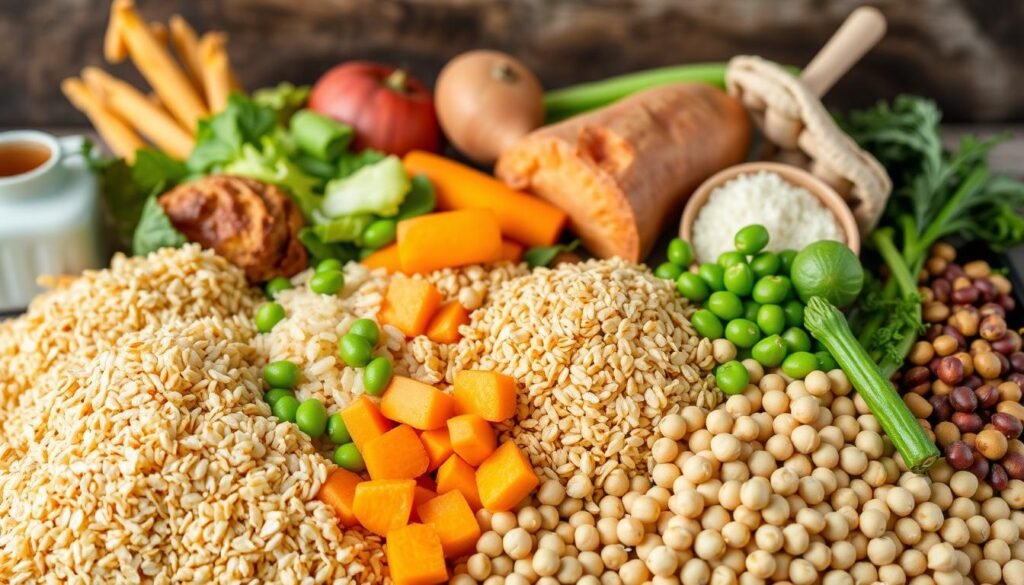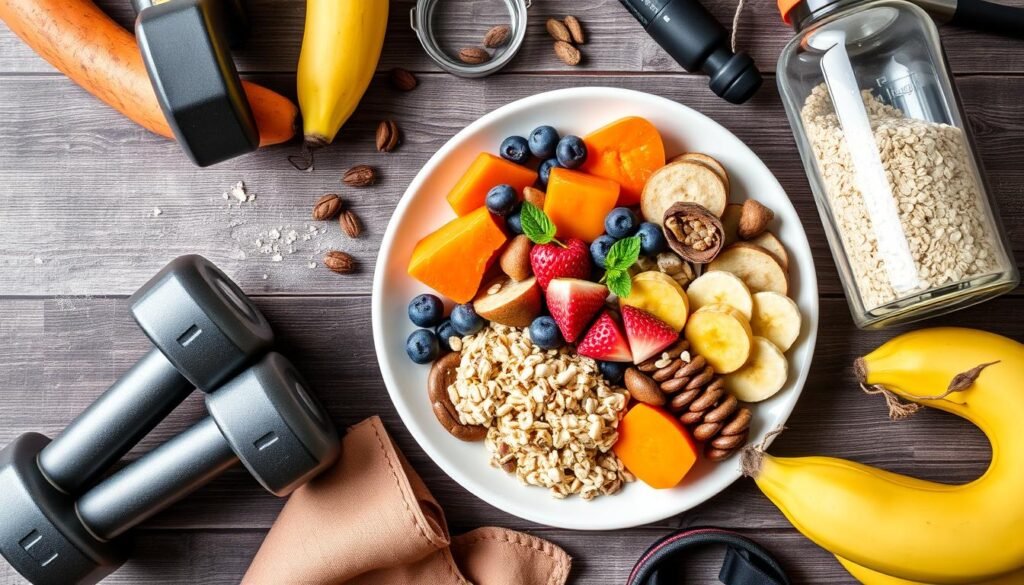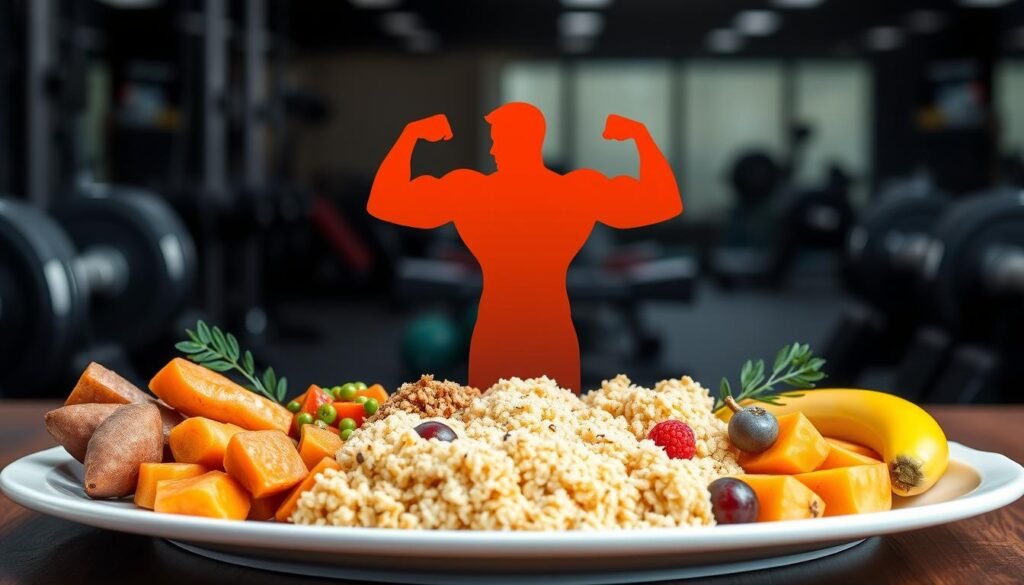Many bodybuilders up their daily calorie intake by about 15% or more during bulking. They aim to maximize muscle gain. Carbohydrates are essential for refilling glycogen stores, crucial for the best strength training. Knowing how carbs aid in bulking and muscle recovery is vital for a better bodybuilding diet.
Training in the gym uses up glycogen stores. Not refilling these carbs can hurt your muscle-building and workout results. Though some research shows high carb intake might not always boost performance right away, it supports better results in long training sessions. For strength athletes, understanding the role of carbs is key. They’re needed for energy and aid in protein metabolism, making workouts more effective.
To learn more about carbs and strength gains, look into a detailed systematic literature review. It has science-backed info on glycogen refilling.
Key Takeaways
- Carbohydrates play a crucial role in replenishing glycogen stores necessary for strength gains.
- Many athletes increase their calorie intake by 15% or more during bulking phases for optimal muscle gain.
- Low carbohydrate diets can lead to negative health impacts, such as weakened immunity and reduced performance.
- Post-exercise carbohydrate intake significantly enhances muscle glycogen synthesis.
- Combining carbohydrates with protein can improve glycogen storage efficiency.
Understanding Glycogen and Its Role in Strength Training
Glycogen is our main stored carbohydrate in the liver and muscles. It is vital for energy during strength training. This helps with performance, endurance, and recovery.
What is Glycogen?
Glycogen stores glucose for high-intensity exercise fuel. An average person has about 600 grams of glycogen. The liver stores over 80 grams of this. Muscle glycogen makes up 1-2% of muscle cell volume. It is essential for exercise energy.
Athletes need lots of glycogen, around 8-12 grams of carbs per kilogram of body weight. This shows how crucial carbs are for their energy in strength training.
How Glycogen Depletion Affects Performance
Intense workouts can use up a lot of glycogen. Research shows resistance training can reduce muscle glycogen by 38% to 39%. This drop in glycogen causes fatigue, affecting your workout.
Running low on glycogen makes athletes tired faster. They can do fewer reps, like dropping from 18 squats to 12. This change happens when carbs are low.
Eating carbs after working out is key for recovery. It refills your glycogen, boosting energy for next time. Keeping glycogen levels high is important for consistent training results.
| Glycogen Storage Information | Value |
|---|---|
| Total Glycogen in Muscles | Approximately 600g |
| Liver Glycogen Storage | >80g |
| Muscle Glycogen as % of Muscle Volume | 1-2% |
| Daily Carbohydrate Needs for Athletes | 8-12g/kg of body weight |
| Average Glycogen Decrease Post-Exercise | 26% – 39% |
The Importance of Carbs for Bulking
Carbohydrates are key for high energy levels and muscle growth. For those who lift weights, eating enough carbs is crucial. They help you train harder and recover quicker. It’s important to eat a lot of carbs if you’re very active.
Carbohydrates as an Energy Source
Carbs are the main fuel when you’re doing strength training. They keep you going strong and help you bounce back after. The Carb Intake Recommendations suggest eating 8 to 10 grams of carbs for every kilogram you weigh. This makes sure your muscles have enough energy for your next workout.
Carb Intake Recommendations for Strength Athletes
The latest Dietary Guidelines suggest 45% to 65% of your calories should come from carbs. If you’re trying to bulk up, aim for a mix of 40-60% carbs, 25-35% protein, and 15-25% fat. Eating carbs right after training and then every 30 minutes helps muscles recover and grow. It’s also smart to have carbs an hour before exercising.
| Carbohydrate Distribution | % of Total Caloric Intake |
|---|---|
| Carbohydrates | 40-60% |
| Protein | 25-35% |
| Fat | 15-25% |
Carbs are very important for athletes who need energy and want to grow stronger. Following these carb guidelines and choosing healthy foods will help improve your workouts. This helps you get stronger and build muscle over time.
Optimal Carbohydrate Sources for Bulking
To bulk up right, knowing the difference between complex and simple carbs is key. Each kind of carb serves a unique purpose in energy production, muscle recovery, and boosting performance overall. A diet high in carbs is very beneficial for those wanting to gain mass.
Complex Carbohydrates vs. Simple Carbohydrates
Complex carbs are crucial for a high-carb diet, especially for athletes. Examples include brown rice, oats, and legumes. They slowly release energy, vital during heavy workouts. For example, a cup of quinoa gives 40 grams of carbs plus nutrients and fiber.
Simple carbs are in things like candy and soda. They provide quick energy but don’t have much nutritional value. Consuming these can make your blood sugar levels unstable, affecting your performance over time.
High-Carb Diet Benefits
A high-carb diet helps athletes in several ways. It speeds up muscle recovery and fills up glycogen stores, important for strength. Eating foods like oatmeal, which has 58 grams of carbs, supports a healthy diet. A banana can give immediate energy and has fiber, too.
Adding legumes, such as lentils, which have both carbs and up to 18 grams of protein per cup, is smart. A good balance of complex carbs and some simpler carbs keeps your energy levels up and your blood sugar steady.

| Food Source | Carbohydrates (g) | Protein (g) | Fat (g) | Fiber (g) |
|---|---|---|---|---|
| Cooked Quinoa (1 cup) | 40 | 8 | 5 | 5 |
| Cooked Lentils (1 cup) | 39 | 18 | 0.4 | 16 |
| Hearty Oatmeal (1 cup) | 58 | 10 | 3.6 | 10 |
| Sweet Potato (1 medium) | 24 | 2 | 0.2 | 4 |
| Cooked Brown Rice (1 cup) | 45 | 4 | 0.4 | 3.5 |
| Cooked Pasta (1 cup) | 43 | 8 | 1 | 2.5 |
Carbohydrate Timing: When to Consume for Best Results
Strategic Carbohydrate Timing is key for improving workout performance and recovery. People often miss how important it is to consume carbs at the right time. This is crucial for fueling workouts and aiding recovery. Planning meals before and after workouts can boost energy and muscle recovery.
Pre-Workout Carbohydrate Needs
For better energy during intense workouts, Pre-Workout carbs are essential. Eating carbs 1 to 4 hours before exercise boosts energy and endurance. Great choices include peanut butter and banana sandwiches, Greek yogurt with berries, or oatmeal with fruits. Keep processed carbs low to ensure nutritional quality and peak performance.
Post-Workout Recovery Nutrition
Post-workout nutrition is crucial for recovery. Eating carbs within 30-60 minutes after exercising helps refill glycogen and aid in recovery. This reduces soreness and helps muscle repair. Good post-workout meals include recovery smoothies, low-fat chocolate milk, or turkey wraps. Combining carbs with protein is best for rebuilding muscles and replenishing glycogen.
To support Recovery Nutrition, eat 0.8-2 grams of carbs per kilogram of body weight after working out.

Effective Carbohydrate Timing boosts performance and recovery. This prepares athletes for future workouts and muscle growth. For more on carb timing and strength gains, check out this informative resource.
Carb Cycling: A Strategy for Bulking
Carb cycling offers a powerful way to eat that helps those aiming for muscle growth. It involves switching between days when you eat a lot of carbs and days when you don’t. This method helps maintain muscle while still encouraging the body to burn fat.
What is Carb Cycling?
Carb cycling is a way to change how much carbohydrates you eat to improve your energy and how your body looks. You eat more carbs on some days, about 2 to 2.5 grams per pound of your weight, and less on others, around 0.5 grams per pound. It’s a strategy that helps your body burn fat without losing muscle, and many athletes have been doing this for years to get better at their sports.
How to Implement Carb Cycling in Your Diet
Starting carb cycling means figuring out how many calories you need based on how active you are. If you’re moderately active, your daily calories should be 18 to 20 times your weight in pounds. For very active people, it’s 20 to 22 times. For example, a 160-pound guy might need about 3,000 calories a day. These calories are split into nutrients that help with training.
A typical carb cycling week could look like this:
- 2 high-carb days (175-275 grams)
- 2 moderate-carb days (150-175 grams)
- 3 low-carb days (100-125 grams)
This plan is designed to burn fat and keep muscle during workouts. It’s important to eat carbs at the right time, especially after working out. Eating carbs then helps your muscles recover and grow. Making a carb cycling plan work might mean talking to a dietitian. They can make sure the plan fits your needs. To learn more about carb cycling for bodybuilding, check out this guide.

Replenishing Glycogen After Workouts
After an intense workout, replenishing your body’s glycogen is crucial. The right food can hugely impact your recovery and next performance. Getting nutrients right after working out is key to refilling muscle glycogen. Studies show muscle glycogen can get back to normal in 24 hours with the right carbs.
Why Immediate Post-Workout Nutrition Matters
For athletes wanting to keep up their game, maximizing glycogen synthesis post-exercise is crucial. Studies suggest eating 0.8 to 2 grams of carbs per kilogram of body weight per hour for best glycogen refill. Eating about 60 grams of carbs within the first 30 minutes after exercise is recommended. This helps with muscle glycogen and overall recovery, and it doesn’t upset the stomach.
Recommended Post-Workout Carbohydrate Intake
Right after exercising, it’s best to go for high-glycemic carbs. It’s advised to eat 1.5 grams of carbs per kilogram of body weight right after working out. This approach helps refill glycogen and gets glucose quickly to your muscles. Adding protein, like whey, helps even more with muscle repair and growth.
| Post-Workout Time Frame | Carbohydrate Intake (grams) | Effectiveness |
|---|---|---|
| First 30 minutes | 60 | Rapid glycogen replenishment |
| Within 2 hours | 1.5 g/kg | Optimal muscle recovery |
| Throughout the day | Varies | Stimulates protein synthesis |
Following these post-workout nutrition tips can really boost recovery. It sets the stage for better training outcomes and athletic performance. By focusing on glycogen replenishment and following the intake advice, athletes can stay energized and manage fatigue better.
Managing Calorie Surplus for Muscle Gain
Gaining muscle is all about managing calories carefully. If you eat more calories than you burn, your body has the chance to grow. Knowing how to keep this balance is key to getting good results.
To grow muscles without gaining too much fat, aim for a 10–20% calorie surplus. This means eating 250 to 500 extra calories every day. This strategy helps increase muscle size and keeps fat gain low.
Finding the Right Calorie Surplus
During their bulking phase, male bodybuilders usually eat about 3,800 calories a day, and women around 3,200. This is much more than during the cutting phase, where intake falls to about 2,400 for men and 1,200 for women. To gain muscle effectively, it’s suggested to increase weight by 0.25–0.5% per week.
For a person weighing 175 pounds, this means gaining about 0.4–0.8 pounds a week. This requires a steady intake of extra calories each day.
Balancing Macronutrients for Optimal Results
The best way to eat for muscle growth includes balancing your nutrients:
| Macronutrient | % of Total Calories |
|---|---|
| Carbohydrates | 45–60% |
| Protein | 30–35% |
| Fats | 15–30% |
Focusing on whole foods makes clean bulking better. It stresses the importance of nutrient-rich foods. Eating like this provides vital vitamins and minerals for recovery and growth. Plus, it ensures a healthy calorie surplus without too much junk food.
Clean Bulking vs. Dirty Bulking: Which is Better?
The debate over clean and dirty bulking stresses the role of diet in fitness achievements. Clean bulking focuses on eating foods full of nutrients to build muscle with little fat. It promotes healthy eating habits for a trimmer body.
The Clean Bulking Approach
Clean bulking suggests eating whole foods such as lean meats, whole grains, and lots of fruits and veggies. It offers a balanced nutrition for bulking, aiding muscle gain and health. Calorie intake is watched, maybe slowing progress, yet it cuts down grocery costs over time. It minimizes the risk of lacking vital nutrients.
Risks of Dirty Bulking
Dirty bulking lets you eat more flexible, often choosing high-calorie, processed foods. It can quicken muscle gain but also increase fat and health risks. Though cheap processed foods might seem attractive, health risks add hidden costs. Eating poorly can raise the danger of diseases like heart issues and diabetes.
Knowing the difference between clean and dirty bulking helps make good fitness choices. A personal mix of these methods might be best for muscle growth and lasting fitness success.
Conclusion
Carbohydrates are key for gaining strength when bulking. They not only refill our glycogen stores but also boost our ability to train hard. It is advised that 50-60% of our total calories should come from carbs. This helps in growing muscles and getting stronger.
It’s important to focus on when and what type of carbs we eat to build muscle. Eating whole foods like fruits, veggies, and whole grains is beneficial. They provide energy and the nutrients needed for muscle repair. After working out, carbs and protein together really help with recovery.
Keeping an eye on total calories is also crucial for bulking up. A balanced carb intake tailored to one’s own needs will support reaching fitness goals. By focusing on good nutrition, individuals can see an increase in both strength and muscle size.